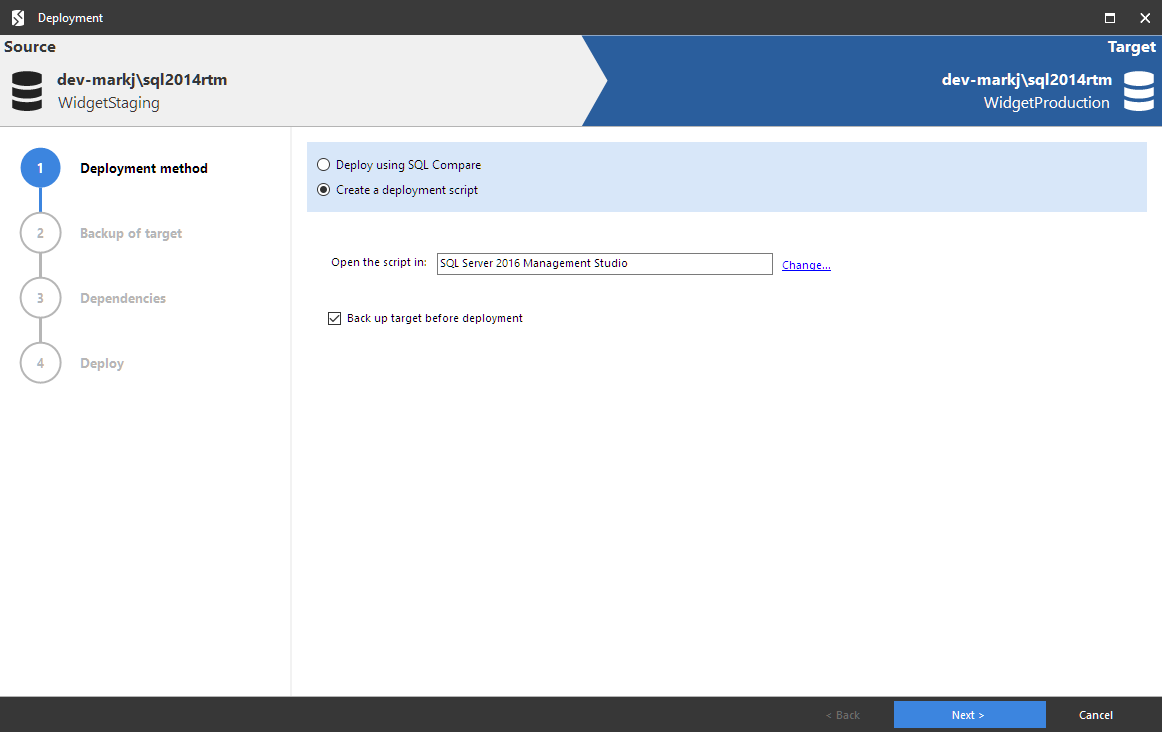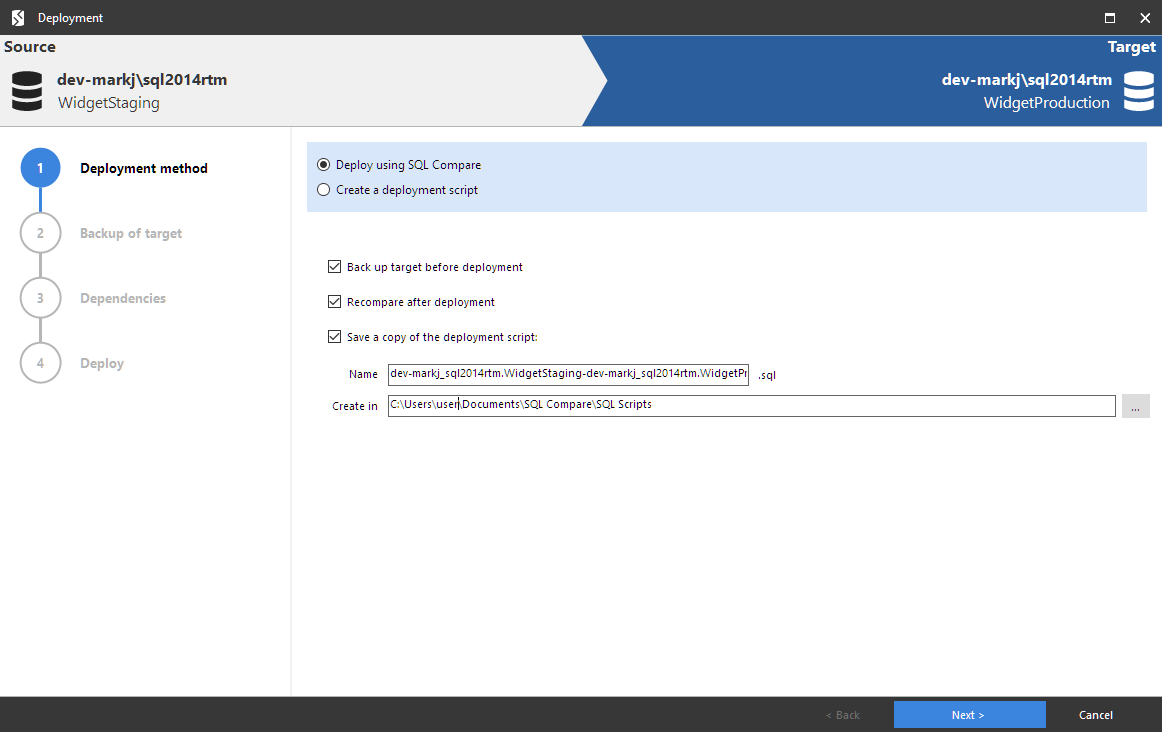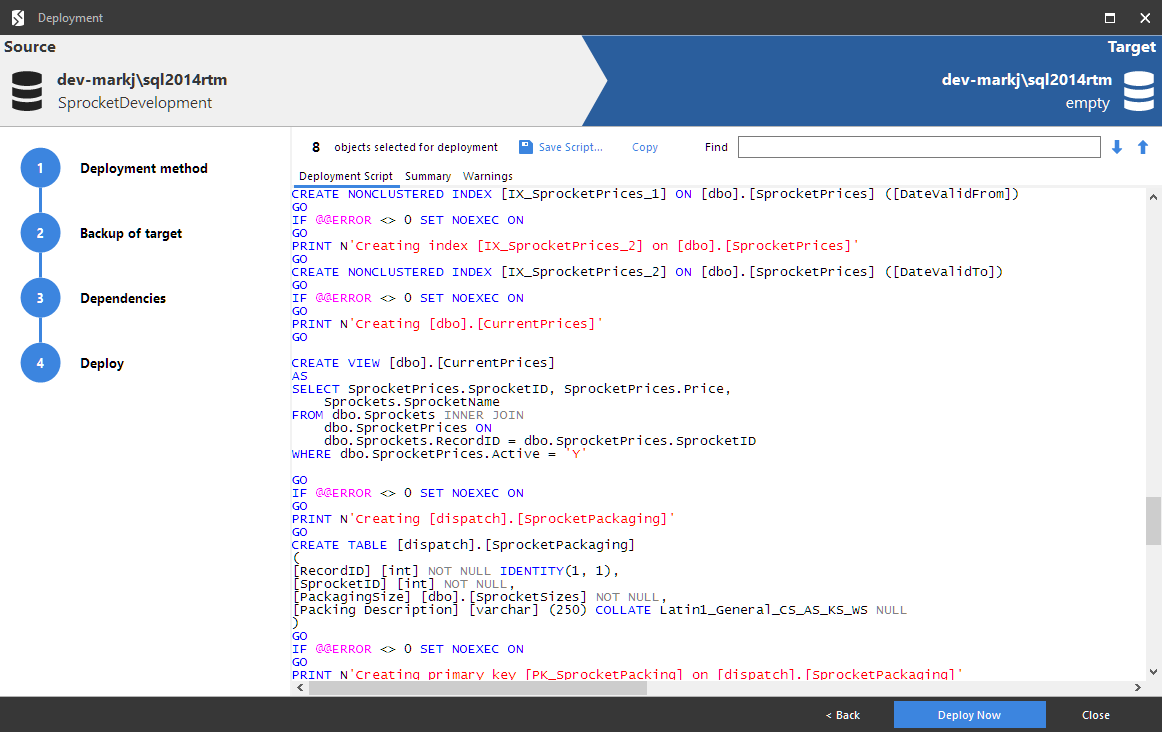Using the Deployment Wizard
Published 21 August 2019
When you have selected the objects that you want to include in the deployment, use the deployment wizard to create the deployment script.
To open the deployment wizard, click .
There are five possible steps in the wizard:
- Choose deployment method
Create and save a script, perform the deployment from SQL Compare, or update a scripts folder. - Configure backup (optional step)
If, on the first page of the wizard, you selected the option to back up before deploying, this additional step is shown. If you do not choose to back up, this step is not part of the wizard. - Review dependencies
View a list of any objects that reference or are referenced by those you have chosen to deploy. You can choose to deploy these objects. - Review deployment script
View the deployment script, review a summary of the deployment actions, and see information about any warnings.
Deploying backups
When you have selected a backup as the target, the deployment wizard creates a script to update the database from which the backup was created. Backups cannot be modified directly.
When a backup is the source, and a database is the target, the deployment script will deploy the database from the backup.
For more information, see Working with backups.
Deploying snapshots
When a SQL Compare snapshot is the target, deployment creates a script to update the database from which the snapshot was created. Snapshots cannot be modified directly.
When a snapshot is the source, and a database is the target, the deployment script will deploy the database from the snapshot.
This is useful, for example, if you want to roll back changes. If you have made changes to a database, and created a snapshot before deployment, you can then set the snapshot as the source, and the database as the target, to roll back the changes.
For more information, see Working with snapshots.
Deploying scripts folders
When a scripts folder is the target, you can either:
- Create a deployment script to update the database from which the scripts folder was created, or
- Update files in the scripts folder directly
If a scripts folder is the target, and any of the script files that will be modified are designated as read-only, a warning is displayed. If you click Yes to continue, these files will be made writable so that they can be modified. This may occur, for example, when you are working with a source control system that sets files to read-only status in some situations.
For more information, see Working with scripts folders.
Additional information
1. Choose deployment method
On the first page of the deployment wizard you can choose to create and save a deployment script, perform the deployment using SQL Compare, or update a scripts folder:
Create a deployment script
If you choose to create a deployment script, on the Review page you can save a copy of the script or open it in your SQL editor.
To change the application you use to open the script, click Change. The Application Options dialog box is displayed, and you can specify the default application used to edit SQL Scripts.
Deploy using SQL Compare
If you choose to deploy using SQL Compare, on the Review page you can save a copy of the script and exit the wizard, or click Deploy now to perform the deployment.
If the target is a scripts folder, this option is instead replaced by Update the scripts folder, and the SQL script files in the target are modified when you deploy.
If you select Back up target before deployment, a step is added to the deployment wizard allowing you to specify details of the backup.
2. Configure backup (optional step)
If you selected the option to back up before deployment, the Configure backup page is added to the deployment wizard.
This page allows you to create a SQL Compare schema snapshot, or a full backup. You can use either Redgate SQL Backup, or native SQL Server to perform the backup.
If the target is a scripts folder, you cannot perform a full backup before deployment. You can only create a snapshot from a scripts folder.
Create a SQL Compare snapshot
A SQL Compare schema snapshot is a binary file containing information about the structure of a database; it does not contain any table data.
This is useful, for example, if you want to roll back changes.
For more information, see Working with snapshots.
Perform a full backup
When the target is a database, you can perform a full backup. In the Back up using box , select:
- Native SQL Server to create a backup using the native SQL Server BACKUP command
- Redgate SQL Backup to create a backup using SQL Backup version 4 or later
For more information, see Backing up before deployment.
3. Review dependencies
When you run the deployment wizard, SQL Compare checks for dependencies:
All the objects you selected for deployment are listed. If they reference or are referenced by objects you did not select, and these dependencies affect the deployment, they are listed on this page.
For example, if a stored procedure references a table, and you do not include that table in the deployment, the table is listed here.
By default, SQL Compare includes these objects in the deployment. To exclude them, clear the Deploy all dependencies check box.
4. Review deployment script
There are three tabs on the Review page:
- Deployment script shows the script to deploy the data sources.
You can search the script, save it, or copy it to the clipboard. - Summary shows a synopsis of the actions in the deployment script.
You can view the summary grouped by the objects affected, by the type of modification, or by the order in which the script modifies the target. - Warnings shows a list of any warnings about unexpected behavior that may occur when you deploy the databases.
For more information, see Deployment warnings.
If you are updating or creating a scripts folder, the Files tab lists the object creation and data script files modified or created during deployment.
When you have reviewed the script, click Deploy now to perform the deployment.











